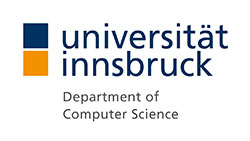Research is the core task of STI Innsbruck. Our motto is "Enabling Semantics". Find out more about our current research directions!
Archive
This page lists the current projects with STI Innsbruck. Please see the archive and the historical projects for more on completed projects.
European e-Freight capabilities for Co-modal transport (e-Freight) The e-Freight project is aimed at supporting, from a transport perspective, the three pillars of European Policy namely:
Specifically e-Freight will contribute to the goals of the Freight transport Logistics Action Plan (Oct 2007), and ITS Action Plan (Oct 2008) pertaining to the development of:
|
FITMAN - Future Internet Technologies for MANufacturing (FITMAN) Website: http://www.fitman-fi.eu
FITMAN is one the 5 Use Case Trials projects selected in the 2nd phase of the FI PPP programme. FITMAN provides the FI/PPP Core Platform with 11 industry-led use case trials which test and assess the suitability, openness and flexibility of FI-WARE Generic Enablers while contributing to the STEEP (social-technological-economical-environmental-political) sustainability of EU Manufacturing Industries. The FITMAN use case trials belong to several manufacturing sectors such as automotive, aeronautics, white goods, furniture, textile/clothing, LED lighting, plastic, construction, machinery for wood, and manufacturing assets management. |
Fred - agent platform for Semantic Web The primary objective is to analyze the agent platform "Fred" and to position it within the existing State of the Art. All with respect to the potential within the area of semantic web and semantic web services. Freds are agents that complete their tasks by communicating and interacting with each other within a central Fred Location. A single Fred Location may host several million Freds performing a variety of different tasks, interacting with each other. A common language ensures that Freds understand each other perfectly and can exchange information based on ontologies. Agent Technologies and especially the Fred platform seems to have the potential to bring semantic web technologies to its full potential. Within this project we will identify further steps realizing this goal. |
GoldenBullet Intelligent Classifier (GB-IC) GoldenBullet is a semi-automatic product classification system. Product classification for warehouse catalogues is a labour-intensive, complicated, time-consuming and error-prone process that requires tremendous efforts. In frequent repeated cycles, millions of millions of products have to be classified with regard to multiple existing standards (e.g. UNSPSC, GPC, e-Class) Furthermore, each of these standards may contain several thousands of target classes or customer specific taxonomies. In the project GoldenBullet we aim to realize an innovative semi-automatic workflow to be delivered as service with a 95% classification accuracy via an integrated web application. This workflow seamlessly combines a fully automated product classifier with accurate manual classification and a background learning process. Further industrial cooperation will be fostered by applying industry scenarios to the workflow. |
Grisino The aim of GRISINO is to combine three leading edge technology strands which complement each other, for the definition of intelligent and dynamic business processes:
|
h-TechSight The objective of the h-TechSight IST project (Coordinated by The University of Surrey in England), is to exploit recent advances in knowledge-based and other systems to harness the potential of the web and turn it into an effective resource to enable businesses to monitor and boost their competitive performance by responding quickly to changes, threats and opportunities, whether local, national or global. The idea is to create a "Virtual One-Stop-Shop", which each business can tailor to its own requirements and priorities. |
Incentives for Semantics (INSEMTIVES) A critical mass of semantically annotated Web pages or multimedia repositories, as well as business-relevant, widely-accepted ontologies would provide a feasible basis for the development of real-world semantic applications, for the adoption of this technology at industrial level, and, why not, for the realization of the Semantic Web vision. It is therefore understandable that the question of how to create semantic content effectively and efficiently has been investigated in several areas related to semantic technologies, ranging from ontology engineering, ontology learning and ontology population, to the semantic annotation of text, media and Web services resources. The result is a maturing inventory of techniques and tools which primarily aim at a complete (or at least partial) automation of the semantic content generation and management tasks, as a means to lower costs and improve productivity. Whilst the quality of such (fully) automated approaches has constantly improved, it is still far from outweighing the manual effort savings achieved, especially when it comes to the creation of meta-data for non-textual sources or the development of a widely accepted ontology, tasks which are human-driven through their very nature. The declared aim of this project is to bridge the gap between human and computational intelligence in current semantic content authoring R&D landscape and to produce methodologies, methods and tools optimally exploiting and combining the two to enable the massive creation and feasible management of semantic contents in an economically based manner, and consequently, to provide the missing building block towards the world wide uptake of semantic technologies. Besides automated ways of semantic content creation, the participation of users who actively contribute to the semantic annotation is the main purpose of the proposed R&D project. For the attraction and motivation of users to engage and cooperate in this process, concepts of community have proven to be a critical success factor. |
InfraWebs The main objective of Infrawebs is ti develop of a set of tools which will help creating, maintaining and executing Semantic Web Services (SWSs). These SWSs will be based on the Web Service Modeling Ontology (WSMO) and interoperable with existing standards such as SQARQL, RDF, WSDL and XML Schema. Each set of tools is deployed within an Infrawebs Integrated Framework (IIF) which is also considered as an Infrawebs Unit. The IIF defines two distinctive (but linked) parts: a Design Time Phase and a Runtime Phase. The Design Time Phase consists of the tools involved during the design of SWSs, whereas the Runtime Phase consists of those tools involved during the execution of SWSs. Some of the tools may of course be involved in both phases. This approach ensures that users of the system (whether developers or normal end-users) deal with the minimum but complete set of tools required. Furthermore, it also provides an environment which is focused on the specific needs of the users. |
ITS Netz The Internet today offers an unmanageable large quantity of information. In order to find information relevant to the user, different search engines exist. Such a search software is DEUS3, a tool for domain-specific search. Although very useful, weaknesses and problems are hidden within DEUS3, which limit the costumer-friendliness and the adaptability of the software to real market conditions. In the course of the project the integratability of data base concepts into the search technology DEUS3 was examined - and accomplished. Now, DEUS3 makes it possible for customers from Austria and the EU member states to develop their own purposeful and meaningful knowledge map on the Internet and maintain these easily on a regularly basis. |
Knowledge Web Website: http://knowledgeweb.semanticweb.org/
In a nutshell, it is the mission of Knowledge Web to strengthen the European industry and service providers in one of the most important areas of current computer technology: Semantic web enabled e-work and e-commerce. We will concentrate our efforts around the outreach of this technology to industry. Naturally, this includes education and research efforts to ensure the durability of impact and support of industry. Therefore, the main Objectives of Knowledge Web are: Outreach to Industry, Outreach to Education, Coordination of Research |
Pages
Contact person in charge.

